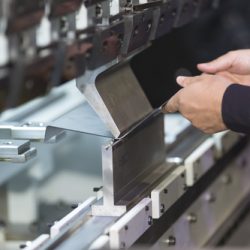Breaking down sheet metal fabrication industry jargon
Sheet metal fabrication can be dated back hundreds of years, with some evidence suggesting that it was around as early as 1400. The sheet metal industry has massively evolved into the industry we know it as today, but to many the concept is still confusing.
To make it as easy as possible for you we’ve put together our top sheet metal techniques to help you get your head around it. From everyday basics in the industry to some less well know techniques, at Yorkshire Laser & Fabrication we use all of the techniques to deliver your exact requirements.
Cutting: Cutting is the process of taking the raw material in the form of sheet metal and cutting it into the basic shape that will then be folded to create a three-dimensional structure in the next stage. There are a number of different ways to cut sheet metal, however the best results are obtained by hydraulic punches, laser cutting, sawing, shearing or chiselling. The cutting technique used varies on the desired outcome and product we are creating.
Bending: The process of bending is typically done by hammering or via press brakes. This process requires specialist machines and expert knowledge to be accomplish successfully. Bending of the sheet metal can be done manually or by machine depending on the outcome that is required.
With thicker sheets press brakes are typically used and for modern thinner sheets CNC folding machines are used.
Metal punching: A process in which metal fabrication equipment punches holes, louvers, or a predetermined shape out of sheet metal. The punching process forces a steel punch, made of hardened steel, into and through a workpiece. Punching has the ability to quickly produce holes of varying shapes and sizes in both strip and sheet metal.
Finishing: All of our metal work is finished to achieve an overall surface or finish. This includes: adhesion or wettability; solderability; corrosion, tarnish chemical, or wear resistance; hardness; electrical conductivity; surface friction control; and blemish removal. Metal finishing often consists of electroplating, which is the process of depositing metal ions onto a substrate via an electric current.
Fastening: Fastening is the process of using self-clinching tools like nuts, studs and spacers to provide torque resistance in applications where the sheet metal is too thin to be secured by other methods.
Shrinking: A process to remove small dents in which the direct damage isn’t severely stretched or torn and the hardness of the buckles isn’t severe.
Where possible we try to remove any technical jargon to make everything as simple as possible for you but as we’ve been operating to the highest of professional standards for over 25 years it can be hard to aboid. We respect the history of sheet metal fabrication, and we also recognise that production methods and technologies are always evolving and advancing.
To this end, we have continually invested in the latest technologies, software and hardware in order to enable our business to meet the needs of a variety of clients. We consider no job too large or too small and pride ourselves on producing the finished product for you or your business at a competitive price and in good time.

